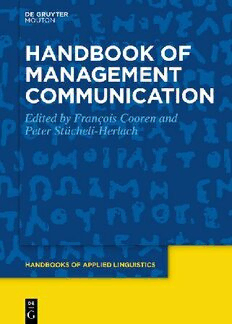
Handbook of Management Communication PDF
Preview Handbook of Management Communication
François Cooren and Peter Stücheli-Herlach (Eds.) Handbook of Management Communication Handbooks of Applied Linguistics Communication Competence Language and Communication Problems Practical Solutions Editors Karlfried Knapp Daniel Perrin Marjolijn Verspoor Volume 16 Handbook of Management Communication Edited by François Cooren and Peter Stücheli-Herlach ISBN 978-1-5015-1655-9 e-ISBN (PDF) 978-1-5015-0805-9 e-ISBN (EPUB) 978-1-5015-0795-3 Library of Congress Control Number: 2021934672 Bibliographic information published by the Deutsche Nationalbibliothek The Deutsche Nationalbibliothek lists this publication in the Deutsche Nationalbibliografie; detailed bibliographic data are available on the Internet at http://dnb.dnb.de. © 2021 Walter de Gruyter GmbH, Boston/Berlin Typesetting: Dörlemann Satz, Lemförde Printing and binding: CPI books GmbH, Leck www.degruyter.com Preface to the Handbooks of Applied Linguistics Series The present handbook constitutes Volume 16 of the De Gruyter Mouton Handbooks of Applied Linguistics. This series is based on an understanding of Applied Linguistics as an inter- and transdisciplinary field of academic enquiry. The Handbooks of Applied Linguistics provide a state-of-the-art description of established and emerging areas of Applied Linguistics. Each volume gives an overview of the field, identifies most important traditions and their findings, identifies the gaps in current research, and gives perspectives for future directions. In the late 1990s when the handbook series was planned by its Founding Editors Gerd Antos and Karlfried Knapp, intensive debates were going on as to whether Applied Linguistics should be restricted to applying methods and findings from lin- guistics only or whether it should be regarded as a field of interdisciplinary synthe- sis drawing on psychology, sociology, ethnology and similar disciplines that are also dealing with aspects of language and communication. Should it be limited to foreign language teaching or should it widen its scope to language-related issues in general? Thus, what Applied Linguistics means and what an Applied Linguist does was highly controversial at the time. Against this backdrop, Gerd Antos and Karlfried Knapp felt that a series of hand- books of Applied Linguistics could not simply be an accidental selection of descrip- tions of research findings and practical activities that were or could be published in books and articles labeled as “applied linguistic”. Rather, for them such a series had to be based on an epistemological concept that frames the status and scope of the concept of Applied Linguistics. Departing from contemporary Philosophy of Science, which sees academic disciplines under the pressure to successfully solve practical everyday problems encountered by the societies which aliment them, the founding editors emphasized the view that was only emerging at that time – the programmatic view that Applied Linguistics means the solving of real world problems with language and communication. This concept has become mainstream since. In line with the conviction that Applied Linguistics is for problem solving, we developed a series of handbooks to give representative descriptions of the ability of this field of academic inquiry and to provide accounts, analyses, explanations and, where possible, solutions of everyday problems with language and communication. Each volume of the Handbooks of Applied Linguistics series is unique in its explicit focus on topics in language and communication as areas of everyday problems and in pointing out the relevance of Applied Linguistics in dealing with them. This series has been well received in the academic community and among prac- titioners. In fact, its success has even triggered competitive handbook series by other publishers. Moreover, we recognized further challenges with language and commu- nication and distinguished colleagues keep on approaching us with proposals to edit https://doi.org/10.1515/9781501508059-201 VI Preface further volumes in this handbook series. This motivates both De Gruyter Mouton and the series editors to further develop the Handbooks of Applied Linguistics. Karlfried Knapp (Erfurt), Founding Editor Daniel Perrin (Zürich), Editor Marjolijn Verspoor (Groningen), Editor Contents Preface to the Handbooks of Applied Linguistics series V François Cooren and Peter Stücheli-Herlach Introducing 1 Part I: Practices of management communication Nicolas Bencherki 1 Speaking 27 Geert Jacobs and Daniel Perrin 2 Writing 47 Theresa Castor and Mariaelena Bartesaghi 3 Deciding 69 Philippe Lorino 4 Creating by communicating 87 Peter Winkler 5 Networking 105 Zhuo Ban and Heather M. Zoller 6 Controlling and resisting 123 Christine Domke and Matthias Klemm 7 Tweeting 143 Viviane Sergi 8 Documenting 161 Salla-Maaria Laaksonen 9 Posting 177 Part II: Forms of management communication Florence Allard-Poesi and Laure Cabantous 10 Strategizing 195 VIII Contents J. Kevin Barge 11 Leading 213 Howard Nothhaft, Alicia Fjällhed, and Rickard Andersson 12 Planning and designing 231 Alex Wright and David Hollis 13 Routinizing 247 Consuelo Vásquez 14 Branding 263 Rickard Andersson and Lars Rademacher 15 Managing communication 279 Patrice M. Buzzanell 16 Mentoring 295 Peter Stücheli-Herlach and Ursina Ghilardi 17 Counseling 313 Christian Schwägerl and Susanne Knorre 18 Developing organizations 335 Bertrand Fauré 19 Accounting 355 Part III: Contexts of management communication Susanne Tietze, Hilla Back, and Rebecca Piekkari 20 Managing communication in multilingual workplaces 373 Philipp Dreesen and Julia Krasselt 21 Exploring and analyzing linguistic environments 389 Jody L. S. Jahn 22 Managing high reliability organizations 409 Shiv Ganesh, Mohan Dutta, and Ngā Hau 23 Building communities 427 Contents IX Dennis Schoeneborn and Verena Girschik 24 Managing CSR Communication 443 Brigitte Bernard-Rau 25 Rating social and environmental performances 459 Anne M. Nicotera, Melinda Villagran, and Wonsun (Sunny) Kim 26 Managing in hospitals 477 Amanda J. Porter, Damla Diriker, and Ilse Hellemans 27 Crowdsourcing 493 Sarah E. Riforgiate and Samentha Sepúlveda 28 Managing and being managed by emotions 511 Samir L. Vaz, Eduardo A. Figueiredo, and Gabriela X. Maia 29 Changing through communication 529 About the contributors 549 Index 559
